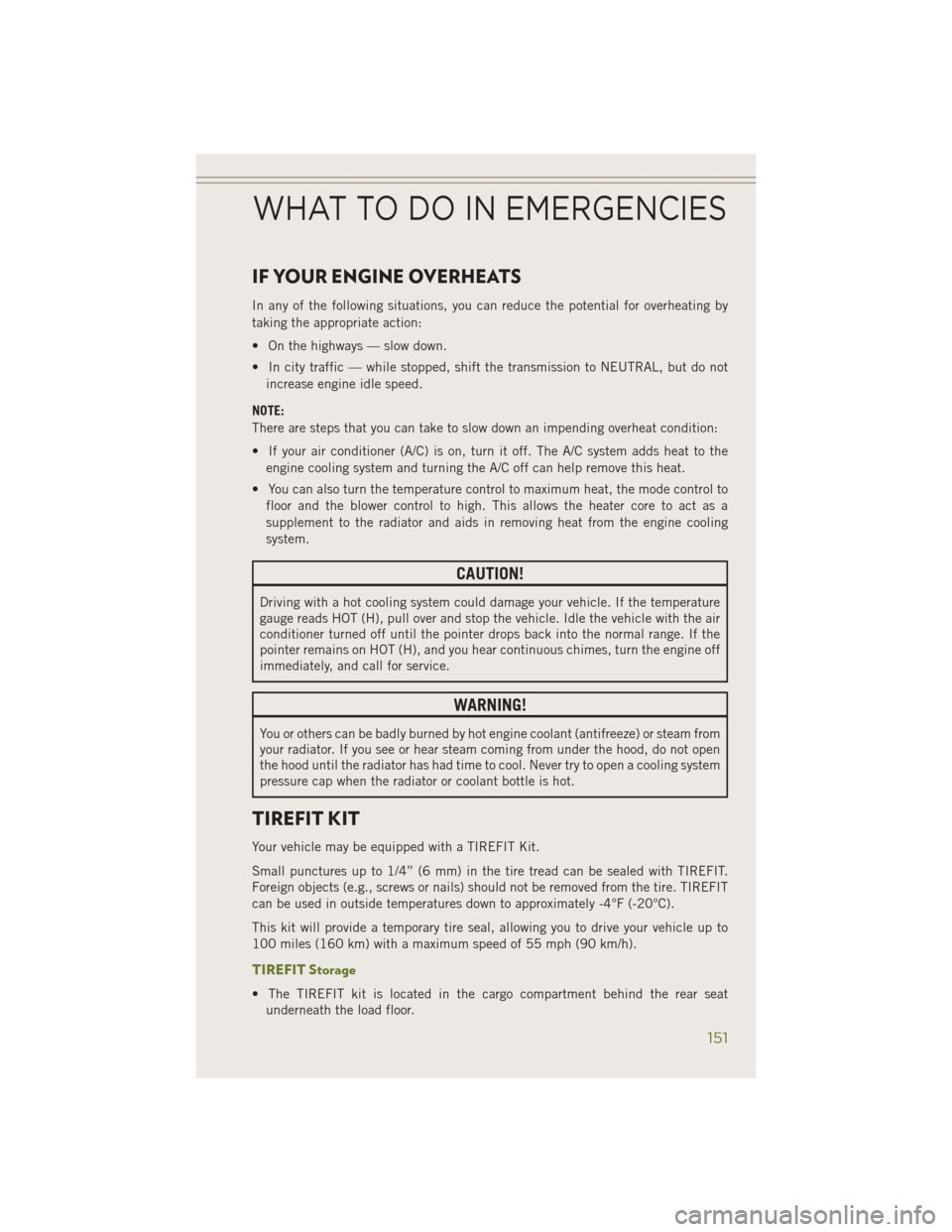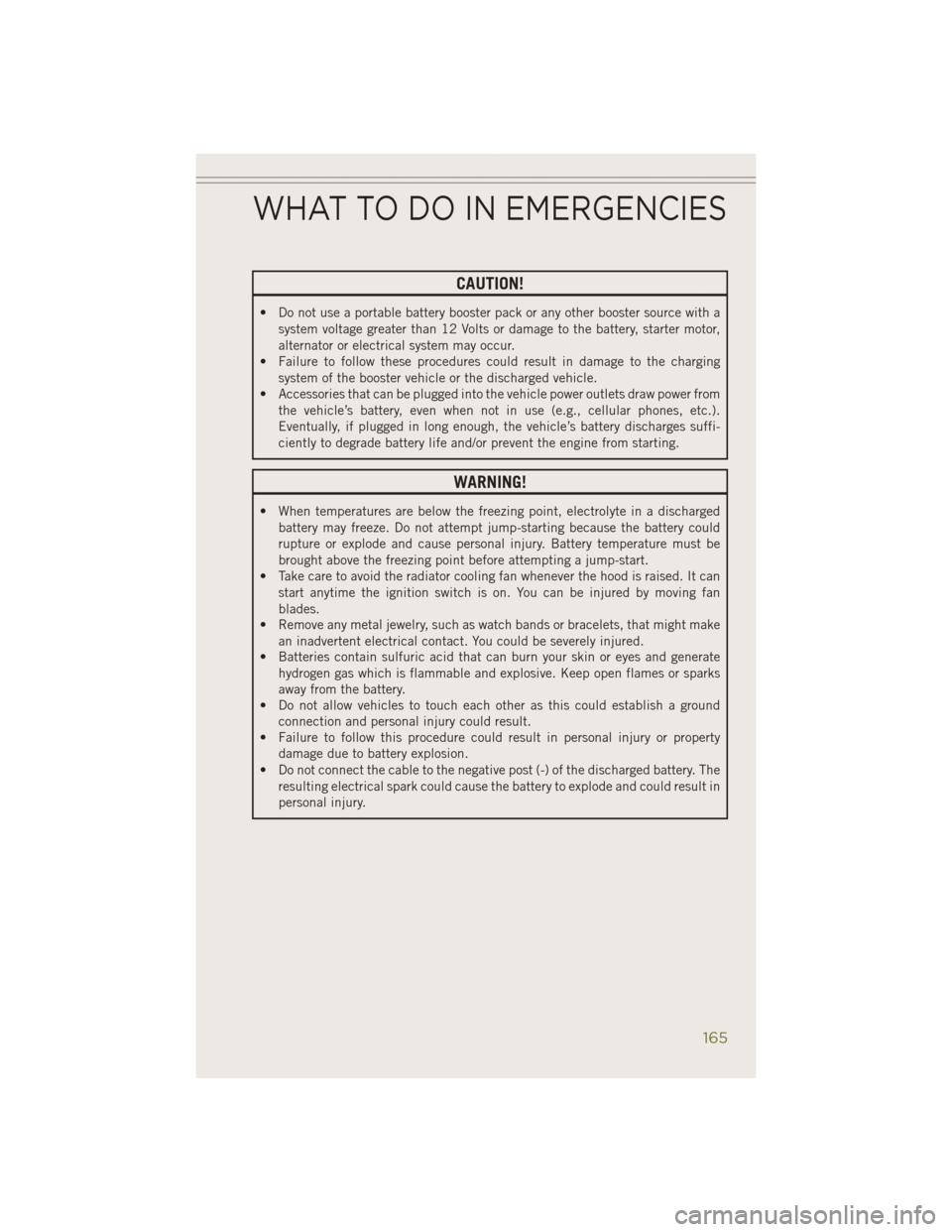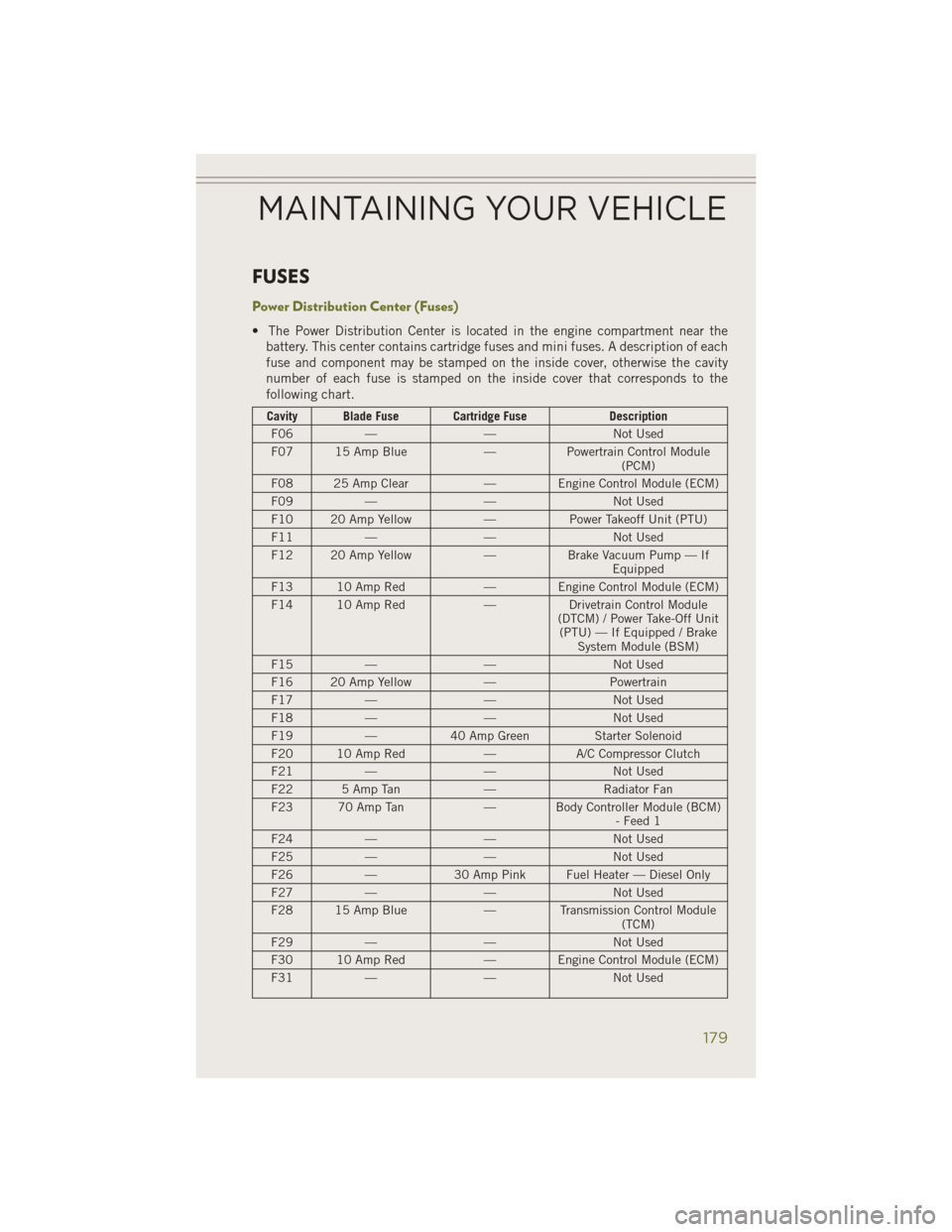radiator JEEP CHEROKEE 2014 KL / 5.G User Guide
[x] Cancel search | Manufacturer: JEEP, Model Year: 2014, Model line: CHEROKEE, Model: JEEP CHEROKEE 2014 KL / 5.GPages: 204, PDF Size: 3.84 MB
Page 153 of 204

IF YOUR ENGINE OVERHEATS
In any of the following situations, you can reduce the potential for overheating by
taking the appropriate action:
• On the highways — slow down.
• In city traffic — while stopped, shift the transmission to NEUTRAL, but do notincrease engine idle speed.
NOTE:
There are steps that you can take to slow down an impending overheat condition:
• If your air conditioner (A/C) is on, turn it off. The A/C system adds heat to the engine cooling system and turning the A/C off can help remove this heat.
• You can also turn the temperature control to maximum heat, the mode control to floor and the blower control to high. This allows the heater core to act as a
supplement to the radiator and aids in removing heat from the engine cooling
system.
CAUTION!
Driving with a hot cooling system could damage your vehicle. If the temperature
gauge reads HOT (H), pull over and stop the vehicle. Idle the vehicle with the air
conditioner turned off until the pointer drops back into the normal range. If the
pointer remains on HOT (H), and you hear continuous chimes, turn the engine off
immediately, and call for service.
WARNING!
You or others can be badly burned by hot engine coolant (antifreeze) or steam from
your radiator. If you see or hear steam coming from under the hood, do not open
the hood until the radiator has had time to cool. Never try to open a cooling system
pressure cap when the radiator or coolant bottle is hot.
TIREFIT KIT
Your vehicle may be equipped with a TIREFIT Kit.
Small punctures up to 1/4” (6 mm) in the tire tread can be sealed with TIREFIT.
Foreign objects (e.g., screws or nails) should not be removed from the tire. TIREFIT
can be used in outside temperatures down to approximately -4°F (-20°C).
This kit will provide a temporary tire seal, allowing you to drive your vehicle up to
100 miles (160 km) with a maximum speed of 55 mph (90 km/h).
TIREFIT Storage
• The TIREFIT kit is located in the cargo compartment behind the rear seatunderneath the load floor.
WHAT TO DO IN EMERGENCIES
151
Page 167 of 204

CAUTION!
• Do not use a portable battery booster pack or any other booster source with asystem voltage greater than 12 Volts or damage to the battery, starter motor,
alternator or electrical system may occur.
• Failure to follow these procedures could result in damage to the charging
system of the booster vehicle or the discharged vehicle.
• Accessories that can be plugged into the vehicle power outlets draw power from
the vehicle’s battery, even when not in use (e.g., cellular phones, etc.).
Eventually, if plugged in long enough, the vehicle’s battery discharges suffi-
ciently to degrade battery life and/or prevent the engine from starting.
WARNING!
• When temperatures are below the freezing point, electrolyte in a dischargedbattery may freeze. Do not attempt jump-starting because the battery could
rupture or explode and cause personal injury. Battery temperature must be
brought above the freezing point before attempting a jump-start.
• Take care to avoid the radiator cooling fan whenever the hood is raised. It can
start anytime the ignition switch is on. You can be injured by moving fan
blades.
• Remove any metal jewelry, such as watch bands or bracelets, that might make
an inadvertent electrical contact. You could be severely injured.
• Batteries contain sulfuric acid that can burn your skin or eyes and generate
hydrogen gas which is flammable and explosive. Keep open flames or sparks
away from the battery.
• Do not allow vehicles to touch each other as this could establish a ground
connection and personal injury could result.
• Failure to follow this procedure could result in personal injury or property
damage due to battery explosion.
• Do not connect the cable to the negative post (-) of the discharged battery. The
resulting electrical spark could cause the battery to explode and could result in
personal injury.
WHAT TO DO IN EMERGENCIES
165
Page 176 of 204
![JEEP CHEROKEE 2014 KL / 5.G User Guide ComponentFluid, Lubricant, or Genuine
Part Capacities
Spark Plugs – 2.4L Engine We recommend you use
MOPAR
®Spark Plugs
(Gap 0.047 in [1.2 mm]) —
Spark Plugs – 3.2L Engine We recommend you use
JEEP CHEROKEE 2014 KL / 5.G User Guide ComponentFluid, Lubricant, or Genuine
Part Capacities
Spark Plugs – 2.4L Engine We recommend you use
MOPAR
®Spark Plugs
(Gap 0.047 in [1.2 mm]) —
Spark Plugs – 3.2L Engine We recommend you use](/img/16/7056/w960_7056-175.png)
ComponentFluid, Lubricant, or Genuine
Part Capacities
Spark Plugs – 2.4L Engine We recommend you use
MOPAR
®Spark Plugs
(Gap 0.047 in [1.2 mm]) —
Spark Plugs – 3.2L Engine We recommend you use
MOPAR
®Spark Plugs
(Gap 0.043 in [1.1 mm]) —
Automatic Transmission We recommend you only
use MOPAR
®ZF 8&9
Speed ATF™ Automatic Transmission Fluid, or equivalent. —
Brake Master Cylinder We recommend you use
MOPAR
®DOT 3 Brake
Fluid, SAE J1703 should be used. If DOT 3, SAE
J1703 brake fluid is not available, then DOT 4 is
acceptable. Use only rec- ommended brake fluids. —
CAUTION!
• Mixing of engine coolant (antifreeze) other than specified Organic Additive
Technology (OAT) engine coolant (antifreeze), may result in engine damage and
may decrease corrosion protection. Organic Additive Technology (OAT) engine
coolant is different and should not be mixed with Hybrid Organic Additive
Technology (HOAT) engine coolant (antifreeze) or any “globally compatible”
coolant (antifreeze). If a non-OAT engine coolant (antifreeze) is introduced into
the cooling system in an emergency, the cooling system will need to be drained,
flushed, and refilled with fresh OAT coolant (conforming to MS-12106), by an
authorized dealer as soon as possible.
• Do not use water alone or alcohol-based engine coolant (antifreeze) products.
Do not use additional rust inhibitors or antirust products, as they may not be
compatible with the radiator engine coolant and may plug the radiator.
• This vehicle has not been designed for use with propylene glycol-based engine
coolant (antifreeze). Use of propylene glycol-based engine coolant (antifreeze)
is not recommended.
MAINTAINING YOUR VEHICLE
174
Page 181 of 204

FUSES
Power Distribution Center (Fuses)
• The Power Distribution Center is located in the engine compartment near thebattery. This center contains cartridge fuses and mini fuses. A description of each
fuse and component may be stamped on the inside cover, otherwise the cavity
number of each fuse is stamped on the inside cover that corresponds to the
following chart.
Cavity Blade Fuse Cartridge Fuse Description
F06 — — Not Used
F07 15 Amp Blue —Powertrain Control Module
(PCM)
F08 25 Amp Clear — Engine Control Module (ECM)
F09 — — Not Used
F10 20 Amp Yellow —Power Takeoff Unit (PTU)
F11 — — Not Used
F12 20 Amp Yellow —Brake Vacuum Pump — If
Equipped
F13 10 Amp Red — Engine Control Module (ECM)
F14 10 Amp Red —Drivetrain Control Module
(DTCM) / Power Take-Off Unit (PTU) — If Equipped / Brake System Module (BSM)
F15 — — Not Used
F16 20 Amp Yellow —Powertrain
F17 — — Not Used
F18 — — Not Used
F19 —40 Amp Green Starter Solenoid
F20 10 Amp Red —A/C Compressor Clutch
F21 — — Not Used
F22 5 Amp Tan —Radiator Fan
F23 70 Amp Tan — Body Controller Module (BCM)
- Feed 1
F24 — — Not Used
F25 — — Not Used
F26 —30 Amp Pink Fuel Heater — Diesel Only
F27 — — Not Used
F28 15 Amp Blue —Transmission Control Module
(TCM)
F29 — — Not Used
F30 10 Amp Red — Engine Control Module (ECM)
F31 — — Not Used
MAINTAINING YOUR VEHICLE
179
Page 182 of 204

Cavity Blade Fuse Cartridge FuseDescription
F32 — — Not Used
F33 —30 Amp Pink Driver Door Module (DDM) —
If Equipped
F34 —30 Amp Pink Body Controller Module
(BCM) — Feed 3
F35 — — Not Used
F36 — — Not Used
F37 —50 Amp Red Voltage Stabilization Module
(VSM) — If Equipped WithStop/Start Engine Option
F38 —50 Amp Red Radiator Fan
F38 —60 Amp Yellow Glow Plugs - Diesel Only — If
Equipped
F39 —40 Amp Green HVAC Blower Motor
F40 —20 Amp Blue Trailer Tow Park Light — If
Equipped
F41 —60 Amp Yellow Body Controller Module
(BCM) — Feed 2
F42 —30 Amp Pink Electric Park Brake (EPB) —
Left
F43 20 Amp Yellow —Trailer Tow Left Stop/Turn
Light — If Equipped
F44 —30 Amp Pink Trailer Tow / 7-Way Connector
— If Equipped
F45 —30 Amp Pink Passenger Door Module (PDM)
— If Equipped
F46 —25 Amp Clear Sunroof — If Equipped
F47 —30 Amp Pink Drivetrain Control Module
(DTCM)
F48 — — Not Used
F49 —30 Amp Pink Power Inverter (115V A/C) —
If Equipped
F50 —30 Amp Pink Power Liftgate — If Equipped
F51 — — Not Used
F52 — — Not Used
F53 —30 Amp Pink BSM-ECU & Valves
F54 —30 Amp Pink Urea Heater Control Unit — If
Equipped With Diesel Engine
F55 10 Amp Red — Blind Spot Sensors / Compass
/ Rearview Camera — If
Equipped / Rear Seat Heater Switches / Trunk LampW/ Flashlamp Charger
MAINTAINING YOUR VEHICLE
180